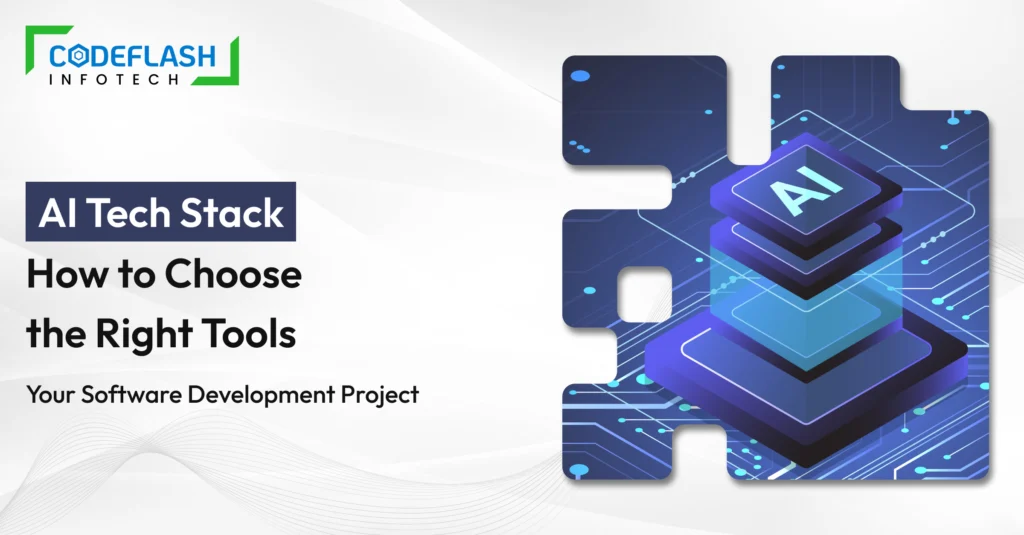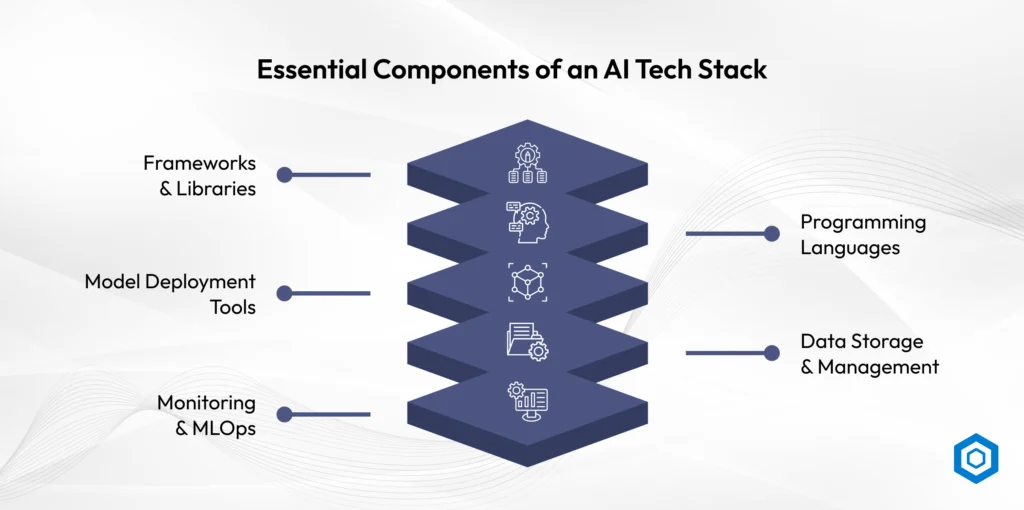
AI Tech Stack: How to Choose the Right Tools for Your Software Development Project
17 JUNE
Selecting the correct AI tech stack matters for both technical and strategic reasons. Your project’s success depends on which technology stack you select for your AI-driven chatbot, predictions, or automation. The revenue in the Software market is projected to exhibit a steady annual growth rate of 3.98% from 2025 to 2030 Choosing from many languages, frameworks, libraries, and tools is hard. However, remembering what your project requires and what different AI technologies are capable of will guide you better.
Factors to Consider When Choosing an AI Tech Stack
Before adopting any AI, you should keep certain factors in mind. The first is the nature of your AI software development project. Are you interested in using AI for natural language tasks, image processing or recommending things to people? Depending on the problem, developers use various frameworks and optimize the hardware differently.
Next, focus on the ability to grow or increase the number of users. If processing lots of data in real-time is a requirement, you must select a technological combination that offers high performance and capacity.
Third, talent availability plays a significant role. Choosing a stack your current team is familiar with—or one for which you can hire AI developers without difficulty—is often more practical than going with the most cutting-edge tools that require a steep learning curve.
See how we’ve helped businesses leverage innovative tech solutions. View our portfolio

Essential Components of an AI Tech Stack
AI work includes several layers that are defined by unique technologies. Here is an overview of what the key components include:
- Programming Languages: Most AI developers use Python since the language is popular and easy to work with. Some projects also make use of R, Java, and Julia.
- Frameworks and Libraries: Most machine learning applications are built and trained using helpful tools like TensorFlow, PyTorch, Keras, and Scikit-learn. They make use of advanced APIs and enjoy good support from the community.
- Data Storage and Management: Storing and Handling Data is Key for AI Systems.Companies commonly use Hadoop, Apache Spark, or solutions on AWS S3 and Google BigQuery to manage many types of data.
- Model Deployment Tools: After the AI models have been trained, they must be transferred into real-life applications. Using Docker, Kubernetes, and TensorFlow Serving makes the process simpler.
- Monitoring and MLOps: It is essential to integrate and monitor your AI applications for high-quality results continuously. MLflow, Kubeflow and DataDog assist in managing how models are developed and used.
Leveraging the Best Tools in the Industry
Today, the market offers a range of powerful AI tools, but choosing the best AI development tools doesn’t necessarily mean choosing the most complex ones. Using the most suitable tools is essential, as they should be tied to your goals and what your team can handle.Off a company is a startup or SME, Azure AI, Google Vertex AI, and AWS SageMaker on the cloud are excellent choices that don’t require investing in their infrastructure.
If your requirements are complex or you have to worry about data protection or low latency, using on-premise solutions or hybrid systems may help.
Have Questions About AI Development? Email us now!
Aligning Your Stack with Project Needs
Your system design should support the goals of your application. When you focus on acting in real time, you’ll require an architecture suited to quickly processing data. When processing sensitive data, ensure compliance and data security are prioritized in your system.
At this point, custom AI development services can make all the difference. Team up with AI specialists to design a system that matches your needs. They can assist you with compatibility problems, avoid mistakes, and shorten the process.
The Role of Developers in AI Success
Technology alone isn’t enough. Skilled developers are the bridge between your AI goals and tangible outcomes. Whether you build an internal team or hire AI developers externally, ensure that the developers you work with are experienced in coding and understanding the nuances of data science, machine learning, and deployment pipelines.
Conclusion
Choosing the correct AI technology is pivotal in your progress with AI. Selecting the proper set of tools is more crucial than depending only on the most advanced tools for your project. The success of your AI project depends on picking the appropriate programming, development, and management tools.
Selecting the correct strategy and getting help from custom AI development services to build it can save you a lot of difficulty and expenses later on. Remember that your stack should be flexible, scalable, and easy to maintain for the years ahead. Your AI project can do well if you have a sensible approach and the best team.
Ready to Build with the Right AI Tech Stack? Contact Us today!

Frequently Asked Questions
All technologies required for working with AI, including development, training and deployment, belong to an AI tech stack. Such a system uses programming languages, frameworks, stores data and deploy tools. Using an appropriate stack can lead to both high performance and the ability to scale.
Due to its simplicity and many libraries built for AI and machine learning, Python is known to be the best language for AI today.
AWS, Google Cloud, and Azure services are available for AI development, helping businesses manage model training, handle data storage and release the AI models.
You should consider hiring AI developers if your employees are not skilled enough to work on advanced AI tasks or when time is essential for faster results.
New users can begin with Scikit-learn, Keras, and Google Colab. They are simple to use, adequately documented, and have lively online communities.




